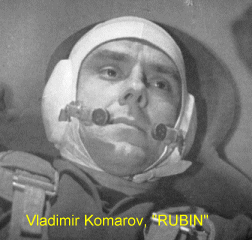 An
analysis of the Soyuz-1 flight
An
analysis of the Soyuz-1 flight An
analysis of the Soyuz-1 flight
An
analysis of the Soyuz-1 flight
|
Yes, voice on shortwaves was received in Berlin on three occasions on 23 April 1967. |
|
Yes, it certainly affected the power situation considerably and one telemetry antenna was lost causing an unsymmertical antenna diagram probably giving intermittent reception. |
|
Sun sensor and ionic sensor problems precluded the establishment of basic orientation modes. (orbital and sun orientation) |
|
Yes, but very little. Just as a health check of the engine. |
|
It's a long story - please read below! One thing is clear, the manual orientation for retro-fire was indeed a difficult task! |
|
Yes, probably, but if so the stories were embellished. |
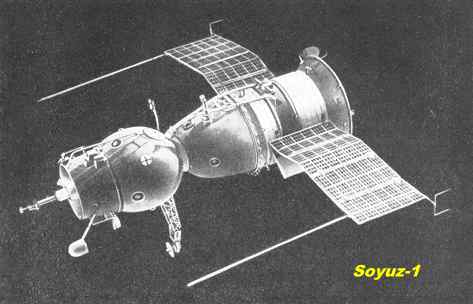 The
flight is announced - Soviet media coverage
The
flight is announced - Soviet media coverageIn the morning of 23 April 1967, Radio Moscow broadcast a special programme about the flight including a recording of a conversation between the cosmonaut and ground control (2). Two progress reports about the flight were issued by TASS at 0500 UT (rev. 3) and at 0800 UT (rev 5) saying that all was well. The latter report said that the cosmonaut would rest from 1030 UT to 1820 UT while the spacecraft was outside the range of Soviet tracking stations. (An analysis of orbital data shows that Soyuz-1 came over the horizon at the far eastern tracking station at Ussuriysk at 1815 UT).
In a letter to Geoff Perry, dated 24 April 1967, I wrote: "Yesterday, I listened on the orbits passing here at 0750-0810 and 0920-0940. At 0810 there was some voice activity on 20.008 MHz, but it impossible to say whether it was Soyuz or not. I also heard some voice transmissions on 20 MHz at 0952......"
In 1999 Geoff Perry wrote (14) about attempts to track Soyuz-1 on 23 April 1967: "......Having learnt of the launch on the 7 a.m. BST (0600 UT) news we would have been monitoring for the overhead rev 5 pass around 9 a.m. (0800 UT) if not for the previous pass at around 7.30 a.m. (0630 UT) We heard nothing. I don't recall the details but I do know that we had no signals at all, hence the decision to spend the night at the School in the expectation of a flight lasting more than one day!
Harro Zimmer,
who was the leader of space-tracking activities at the Wilhelm Foerster
Observatory in Berlin during the 1960's writes: During
the mission we had no telemetry reception on 15.008 and
20.008
MHz! There were only voice receptions on 18.035 MHz. We used a 3
element
- Yagi - steerable Yagi antenna for our HF - reception...." He
goes
on to describe what is in his logbook (11):
| Rev |
|
Harro Zimmer's notes |
| 2 | 03:37:45 - 03:42:10 | Russian voices, very hectic, identification of the call sign 'Rubin'. (Very noisy, virtually no Doppler shift) Our impression was, that we heard the ground station network maybe mixed with communication from Soyuz-1. |
| 3 | 05:07:20 - 05:13:00 | Komarov's message (see below) started, typical "HF - sound", then unintelligible. No note about Doppler shift. |
| 4 | - | No voice, some CW and teletype signals with with fading but definitely 800 - 1000 Hz above our "Soyuz frequency" . |
| 5 | - | No voice, some CW and teletype signals like above. Remarkable: "switching signals every few seconds on 18.036 MHz" |
| 6 | 09:45:05 - 09:46:55 | "Switching signals" mixed with Russian voices. Clear reception of the call sign 'Rubin' (three times). No Doppler shift. |
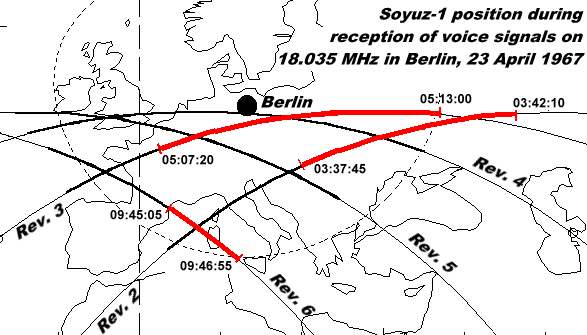
Analysis of available orbital data shows that Soyuz-1 was over the horizon (or just beyond) in Berlin at the time when the Wilhelm Foerster Observatory picked up voice (See map above). This seems to indicate that it was mainly downlink that they heard because the reception times coincided well with the periods when the spacecraft was above or just below the horizon. Harro Zimmer also mentions signals from ground controllers, so it seems that simplex was used. But, why did not the Kettering Group hear these signals? It seems that when they listened on rev 5 Soyuz-1 was not transmitting and the signals picked up in Berlin on rev 6 lasted only less than two minutes, easy to miss if the propagation conditions were marginal.
In (7) we can read: "... It was on the second orbit [rev.1 in NORAD/Space Command parlance, S.G.] that controllers first established stable communications with Komarov on ultra-short wave frequencies; for reasons unknown, the short-wave system was inoperable. Komarov calmly reported: .......... Short-wave communications are not working. ..........." However, Harro Zimmer's receptions seem to indicate that these problems with HF communications did not happen on rev. 0 as indicated in (7) but rather on rev 3, since there was no HF voice in Berlin on rev 4 and 5. (A separate article about Soyuz Radio Systems describes the HF and VHF radio channels)
The message from Vladimir Komarov mentioned by Harro Zimmer is available! In it Komarov makes a political statement: 'for (or in the benefit) of the peoples of our fatherland along the for the whole humanity famous way to communism. Pilot-cosmonaut Komarov.' ('Privet narodam nashej Rodiny, prokladyvayushchim put'k kommunizmu. Letchik-kosmonavt Komarov.'). The controller on earth did not catch the whole message and asks for a repeat. (12)
Upon entry into orbit the ships's sun sensor was inoperable - possibly due to contamination from thruster exhausts. So, sun orientation mode was difficult to achieve. Why this could not be done using manual control and the shade gauge is not explained in (7) or elsewhere. On the fifth orbit (rev 4) Komarov tried to use the periscope and the earth's horizon to orient the craft. So, it seemed the Komarov was trying to establish the first step in achieving the orbital orientation mode. Why he tried this mode when he really neeeded the sun orientation mode is difficult to understand. Perhaps because entry into the sun orientation mode is always from the orbital orientation mode. However, he found it difficult to keep the constantly moving earth in the center of the periscope. Using the ionic sensors to orient the craft in yaw obviously also failed (7). On the thirteenth orbit (rev 12) Komarov again reported problems with the ionic sensors. So, the attitude control system now suffered from two failures; the sun sensor and the ionic sensors.
Suppose that the spacecraft -Y axis (see article about the Soyuz attitude control system) was pointing roughly in the nadir direction, then the average power received by the single solar panel can be estimated using the knowledge that the sun was roughly in the orbital plane. Such an estimate shows that only about 20-25 % of the expected power was received from the solar panels.
Siddiqi-1 (7)
mentions that a "back-up telemetry antenna was inoperable". This
is evident when we examine the configuration of the Soyuz craft. Each
solar
panel was equipped with a U-shaped
telemetry antenna. These antennas were probably fed in parallel via
a diplexer to provide an omnidirectional coverage. When one solar panel
did not deploy one of these antennas was folded up and this caused a
large
gap in the omni-directional antenna pattern, maybe even causing
intermittent
telemetry reception at ground stations.
Harro Zimmer writes about the same morning: ".....But I can definitely say that we heard nothing during the evening, the night and the early morning of April 24 on all three frequencies - no voice, no telemetry. .......... We had extremely bad ionospheric conditions. Between 01.00 and 06.00 UTC (April 24) we had also looked for a US satellite on 20.005 MHz without success....."
In 1999 Geoff Perry writes about the same morning:"..On the night of 23 April 1967, ..., I slept on a camp bed in the Prep Room of Physics "A" at the Kettering Grammar School Science Laboratories in Windmill Avenue, armed with an alarm clock and three short wave receivers, tuned to 15, 18 and 20 MHz, in the hope (and expectation) of receiving signals from Soyuz-1. "
Since shortwaves was "dead" the chances of picking up HF telemetry and voice from Soyuz-1 were slim indeed. During the recovery rev, the spacecraft passed so low over Europe that most observers did not have the spacecraft over the horizon. Those who did, notably in Germany, had the additional problem that shortwave transmitters were probably cut off at that time, since shortwave transmitters were deactivated at descent module separation which occurred at 0309 UT, before the craft came over the horizon.
Thus, the radio observatory at Bochum, which was run by Heinz Kaminski reported that it picked up voice (!) from Soyuz-1 at 0311-0315 UT (8). Dieter Oslender, who lives not very from from Bochum, at Bonn-Röttgen, said he had a weak, fluttery CW signal on 20.008 MHz at 0311.05-0315.45 UT. It is remarkable that the spacecraft was above the horizon at this time (see table below). However, the shortwave transmitters on the pre-Soyuz TM versions (Soyuz TM carries no HF transmitters in orbit) were all switched off at descent module separation. Since descent module separation occurred at 0309:20 UT, the Bochum-Oslender observations seem a bit strange. But, maybe on this particular occasion only CW-PDM modulation was removed from the transmitter leaving only a CW signal. The fact that no-one picked up any telemetry on 20.008 MHz prior to descent module separation may be caused by the very bad propagation conditions during the early hours of 24 April 1967. In summary, the Bochum-Oslender observations are not entirely convincing.
SATELLITE: Soyuz 1 Elset: After retro burn
SITE: Bochum Lat: 51.28 Long: 7.11
Date Time UT Lat. Long Alt Ill Vis Range Azim Elev
-----------------------------------------------------------------
1967 Apr 24 03:10:42 39.20 4.01 155 Ecl 1386 191.4 0.2
1967 Apr 24 03:13:00 44.43 13.99 141 Sun 938 143.3 4.5
1967 Apr 24 03:14:54 47.91 23.64 129 Sun 1266 101.0 0.2
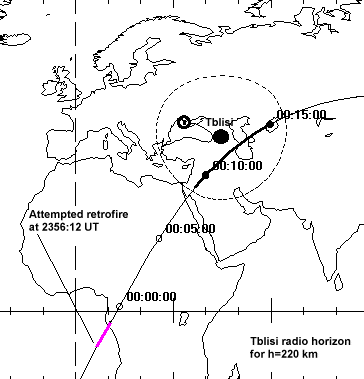 First and second
recovery attempts
First and second
recovery attemptsA Japanese communications laboratory reported receiving signals from Soyuz-1 at 0030-0100 UT (3).TASS reported again routinely that a communications session had been held with the cosmonaut at 0150 UT.
The method chosen was to use manual control to align the spacecraft so that the -Y axis (see article about the Soyuz attitude control system) pointed to nadir and so that +X axis pointed in the direction of flight. This was probably done by using the periscope. Once this attitude was established it would be held by using thruster commands from the gyro package. However, if the gyro inertial attitude hold mode was used the alignment with the velocity vector must have been made 180 degrees away from the retrofire point, since the retrofire point was in darkness. The antipode of the retrofire point was north of New Zealand, far from Soviet ground stations and tracking ships.
The alignment of the Soyuz may have been made on rev 16, since ref (7) says that Komarov would align the spacecraft in sunlight, then check the attitude again after an eclipse period. For this method to have worked, the alignment must have been made on rev 16, since there would be only one sunlight period between passing Russia on rev 17 and the retrofire instant. If this is the way retrofire attitude was established, Komarov was given a difficult task indeed. The map below shows where the spacecraft entered and exited eclipse during the last revolution around the earth.
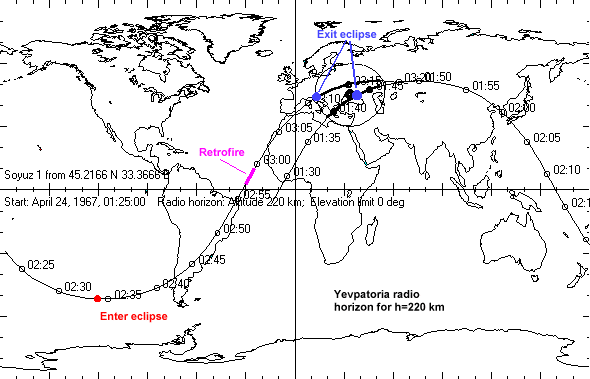
SATELLITE: Soyuz 1 Elset: After retro burnThe ground station noted the indication through telemetry of attitude loss ("Avaria 2" = "Emergency 2") which was an indication from gyros in the descent module that the deviation from nominal attitude was larger than 8 degrees. This deviation also caused the control system to inhibit the use of a lifting re-entry.
SITE: Yevpatoria, YEV Lat: 45.2166 Long: 33.3666
Date Time UT Lat. Long Alt Ill Vis Range Azim Elev
-----------------------------------------------------------------
1967 Apr 24 02:59:00 4.62 -29.32 194 Ecl
1967 Apr 24 03:12:00 42.28 9.43 147 Ecl
1967 Apr 24 03:13:00 44.43 13.99 141 Sun
1967 Apr 24 03:14:00 46.37 18.90 135 Sun 1149 281.7 1.9
1967 Apr 24 03:15:00 48.07 24.18 128 Sun 788 297.6 5.9
1967 Apr 24 03:16:00 49.48 29.82 121 Sun 563 331.8 9.9
1967 Apr 24 03:17:00 50.59 35.77 114 Sun 639 15.9 7.4
1967 Apr 24 03:18:00 51.34 42.00 106 Sun 947 40.1 2.2
1967 Apr 24 03:19:00 51.74 48.40 99 Sun
1967 Apr 24 03:20:00 51.75 54.87 91 Sun
1967 Apr 24 03:21:00 51.37 61.31 84 Sun
The landing phase normally comprises descent module separation at 723 seconds after the start of the retroburn (T0), parachute deployment at 7 km altitude 26 minutes after T0 and landing at T0 + 39 minutes 27 seconds. According to (7) the landing occurred at 0324 UT i.e. 27 minutes after T0. The landing point is located at 51° 21' 40.62" N, 59° 33' 44.73" E (16 ), approximately 67 km east of Orsk, just north of the Russia-Kazakhstan border. This is consistent with a purely ballistic re-entry and no parachute deployment.
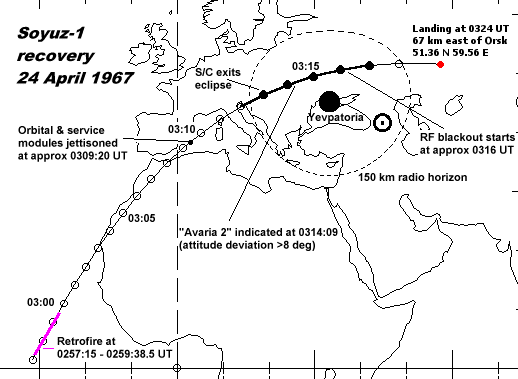
Siddiqi-1 (7) describes in detail how the drogue parachute was unable to pull the main parachute out of its container. Then the reserve parchute was released but prevented from filling with air by the still-attached drogue chute. Soyuz-1 then hit the ground at 40 meters/second at 0322:52 UT (7). The search party in the air could see the descent module on the ground without any associated parachute and they also saw the soft landing rockets fire. The descent module caught fire and the landing spot was engulfed in smoke. The capsule was in such a state that rescue crews could not find Komarov when they landed and approached the burning wreckage.The rescue teams reported somewhat cryptically by radio that the capsule had been spotted and that "the cosmonaut needs urgent medical attention" and then ceased transmitting in order to preserve secrecy. The control center involved in the flight therefore were cut off from all information.
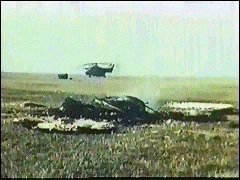 General Kamanin, head of cosmonaut training, who arrived at
Orsk at about
0530 UT, was told that the capsule was on fire and that the cosmonaut
had
not been found.
General Kamanin, head of cosmonaut training, who arrived at
Orsk at about
0530 UT, was told that the capsule was on fire and that the cosmonaut
had
not been found.
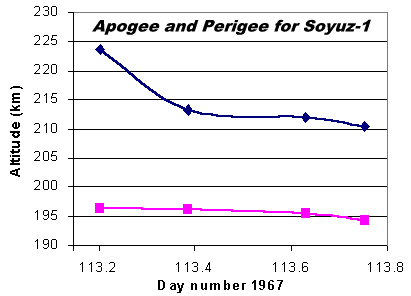 Did
Soyuz-1 maneuver?
Did
Soyuz-1 maneuver?As can be seen below later element sets from NORAD show a significantly lower apogee. (The curve fitted to the data points is somewhat misleading). Maybe the first element set was inaccurate, as is often the case. The problems with stabilisation during early orbits certainly make it hard to envisage that an orbital correction was actually made just judging from these elemnt sets..
In any case, we now know that a
minor maneuver to check the health of the engine was made at 0700 UT on the 23rd
when the main angine was run for 7 seconds providing a delta-v of about 3 m/s (Siddiqi-2).
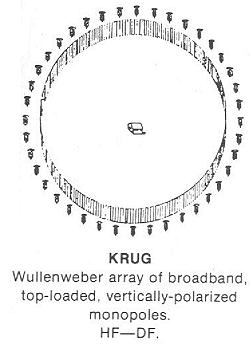 Winslow
Peck was quoted in US magazines and newspapers in the 1973-1975 period
as having worked at an NSA listening post in Istanbul in 1967-68 and
overheard
tapes with the last words of Vladimir Komarov. The reports were very
sensational
and James Oberg was able to contact Peck (a pseudonym for Perry
Fellwock)
to interview him (9). Oberg found out that
Winslow Peck was stationed at an NSA monitoring station in Istanbul
from
January 1967 until October 1968. Around 0900-1000 UT on 24 April 1967
he
listened to a tape of Komarov's voice that was 45 minutes long and
probably
a composite. If over-the-horizon VHF voice communications were
monitored
the periods over the Instanbul horizon was 34 minutes. If you add HF
intercepts
from the post-landing phase, this could easily add up to a 45 minute
composite
tape.
Winslow
Peck was quoted in US magazines and newspapers in the 1973-1975 period
as having worked at an NSA listening post in Istanbul in 1967-68 and
overheard
tapes with the last words of Vladimir Komarov. The reports were very
sensational
and James Oberg was able to contact Peck (a pseudonym for Perry
Fellwock)
to interview him (9). Oberg found out that
Winslow Peck was stationed at an NSA monitoring station in Istanbul
from
January 1967 until October 1968. Around 0900-1000 UT on 24 April 1967
he
listened to a tape of Komarov's voice that was 45 minutes long and
probably
a composite. If over-the-horizon VHF voice communications were
monitored
the periods over the Instanbul horizon was 34 minutes. If you add HF
intercepts
from the post-landing phase, this could easily add up to a 45 minute
composite
tape.
Winslow Peck also told Jim Oberg that the tracking sites that had been monitored were sites in the "Crimea, Transcaucasus, and near TyuraTam" (Yevpatoria, Tbilisi, Dzhusaly).Peck said that signals were picked up by antennas called "KRUGG" (10). This is quite strange, because "KRUG" is the code name for a Soviet direction finding circular antenna array ("Krug" means "Circle" in Russian). See picture on the right from page 263 of the 1976-77 issue of the International Countermeasures Handbook. The corresponding U.S. system is called the Circularly Disposed Antenna Array (CDAA) covering a 10:1 bandwidth on shortwaves and manufactured by GTE Sylvania in Mountain View California. Perhaps the NSA jargon was to call its own system by the Russian name of a corresponding system.
According to Peck he had most of the tape translated to him by friends. He understood that there was trouble with "stabilization" and that Komarov replied to commands from the ground by saying "I'm doing it...it still isn't working..." He kept asking "How long till re-entry?". These purported comments from Komarov all seem quite plausible, but Peck also mentions very emotional conversations between Komarov and his family and also emotional exchanges with a person denoted "K" which seem to indicate that all involved realized that Komarov would die. We now know that everyone expected Komarov to come down safely, so these recollections by Peck weaken his credibility on this particular point.
The table below shows that Soyuz-1 did not come over Istanbul's horizon for more than about two minutes on rev 16, but for seven minutes on rev 17. This would have been an opportunity to pick up Komarov's voice.
SATELLITE: Soyuz 1At the end of the tape Komarov's voice was supposed to have been heard saying "the parachute is wrong" and "heat is rising in the capsule".... Soyuz-1 was above the Istanbul horizon only up until the beginning of the black-out. So this seems to indicate that Komarov was heard via shortwaves. In early Soyuz versions all HF transmissions stopped at descent module separation. Of course HF antennas could have been carried on the descent module, but they would not be of much use. Any whip antennas would soon burn up upon re-entry. In later versions of Soyuz the HF transmitters are only activated after parachute deployment. Between descent module separation on parachute deployment the only link is via VHF/FM voice (121.75 MHz). The antenna for the VHF/FM link is embedded in the descent module hatch. Possibly, Komarov's reports on VHF were relayed on shortwaves and this relay was picked up in Istanbul.
SITE: Istanbul Lat: 41.02 Long: 28.57
Date Time UT Lat. Long Alt Ill Vis Range Azim Elev
-----------------------------------------------------------------
1967 Apr 24 00:10:00 29.84 36.90 198 Ecl 1484 146.1 1.1
1967 Apr 24 00:11:00 32.66 40.10 199 Ecl 1416 128.5 1.8
1967 Apr 24 00:12:00 35.37 43.52 200 Ecl 1482 110.8 1.2
1967 Apr 24 01:39:00 31.47 16.20 198 Ecl 1566 230.2 0.3
1967 Apr 24 01:43:00 41.75 31.02 202 Ecl 301 67.6 41.0
1967 Apr 24 01:46:00 47.65 45.34 204 Sun 1556 55.5 0.6
It is curious that Peck says that uplink was heard after the crash. He also said that ground crews were overheard to discuss the accident. This could only have been on shortwaves. The heavy use of strong broadcast relay stations for HF uplink is known from observations by C.M. van den Berg. Therefore, Peck may be right about this part of the story. In summary, I agree with Jim Oberg that Peck probably heard a tape of Komarov's voice, but that his limited knowledge of Russian caused him, or the people who interpreted for him, embellished what they heard.
|
|